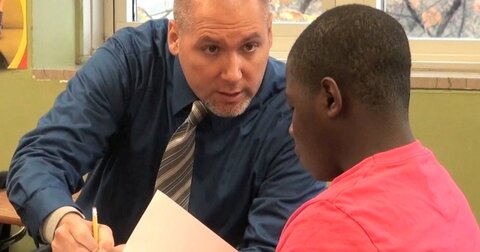State Superintendent Advocates Hiring More Teachers in Detroit
But MDE approved DPS plan to reduce deficit by eliminating teachers
In response to media reports last September alleging that the Detroit Public Schools had a teacher shortage, State Superintendent Michael Flanagan issued a press release discussing ways to hire more teachers. One idea was to expand a law that lets retired teachers collecting pensions “double dip” by returning to work and collecting a paycheck alongside their monthly pension check. Under current law this is permitted only in certain “critical shortage” situations.
Ironically, a month earlier the state superintendent’s own Department of Education had approved teacher reductions as a major component of a deficit-elimination plan for the Detroit Public School district, which has been in red ink since 2008.
The Detroit district’s deficit has increased the past three years to $169.46 million, prompting Gov. Rick Snyder to appoint another emergency manager to oversee the district’s finances, the fourth in a row.
Asking the district to reduce its deficit without addressing staffing issues seems unrealistic. In 2013-14, 48 percent of the district’s operating expenses – $346.7 million – were for “instructional expenditures.”
Also, it’s not clear that Detroit really does have a shortage, given the number of teachers it employs in relation to the number of students. While the media was reporting a shortage, the district reported having 2,836 classroom teachers for a student enrollment of 47,238 in 2014-15, according to November 2014 unaudited figures. That is one teacher for every 16.65 students.
Other large districts in the state have higher ratios. In the 2013-2014 school year Utica Community Schools had one teacher for every 19.1 students and Warren Consolidated Schools one for every 17.2 students.
"DPS can't hire more teachers – the district is in a financial emergency,” said Audrey Spalding, the education policy director for the Mackinac Center for Public Policy, in an email. “Instead, in order to serve Detroit students, officials need to focus on managing teachers more effectively. There is one Detroit teacher for every 17 students. With that many teachers, why can't the district keep its class sizes reasonable?"
The need for teachers in Detroit has been dwindling for years due to reduced enrollment. A failure to adjust staffing levels to reflect this decline has played a major role the district’s ongoing overspending issues. Yet DPS has been reluctant to follow through on proposed staff reductions. The failure has been documented in the district’s own Deficit Elimination Plans:
- 2007-08: “DPS was unable to layoff the recommended number of staff members without interrupting instruction or support services.”
- 2008-09: “DPS was not able to layoff the recommended number of positions without impacting the quality of service to students and staff.”
- 2009-10: “Several employee categories were slated to be released during 2009-10. However, the decision was made to rescind these layoffs to avoid classroom disruption.”
DPS predicts drops in enrollment to continue, which means the district will need fewer teachers. It has told the state it plans to eliminate 152 teaching positions through 2019 for a savings of $13 million, and projects enrollment to drop from 47,107 in 2015 to 40,809 in 2019.
Those figures suggest that for every decline of 41.4 students the district plans to reduce its staff by just one teacher.
Martin Ackley, spokesman for the Michigan Department of Education, said local districts are responsible for their own budget and staffing decisions.
“In dealing with any district’s proposed deficit elimination plan, the Michigan Department of Education does not dictate where or what a district should cut. Those are considerations and decisions made by the district leaders,” Ackley said in an email.
Michigan Capitol Confidential is the news source produced by the Mackinac Center for Public Policy. Michigan Capitol Confidential reports with a free-market news perspective.


 Wayne-Westland School District facing $30M deficit
Wayne-Westland School District facing $30M deficit
 How to strike a healthy balance between parents and teachers
How to strike a healthy balance between parents and teachers
 Flint teachers skip school as student proficiency hits single digits
Flint teachers skip school as student proficiency hits single digits